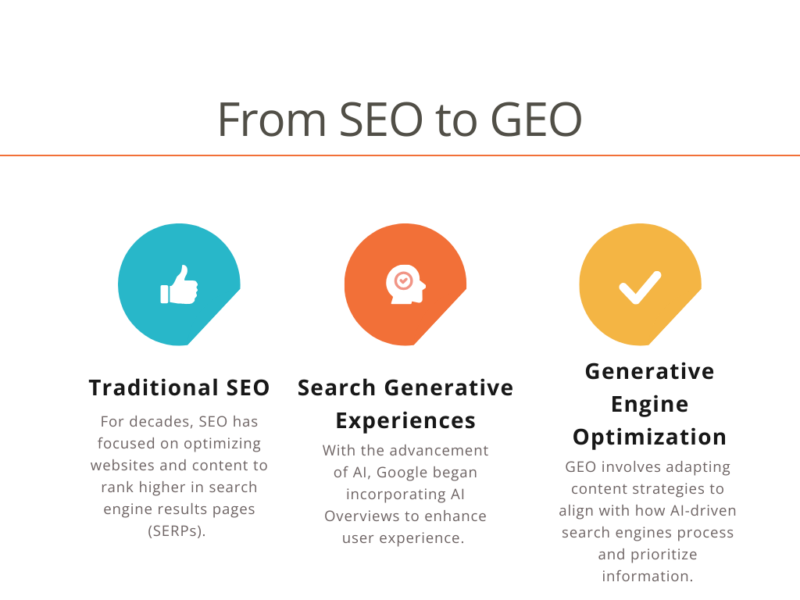Optimize Content for AI Search with Generative Engine SEO
A new search paradigm is emerging. And that trend is using generative AI for search.
Traditional SEO has focused on optimizing content for Google’s algorithm. Digital marketers optimized content and configured web pages to make them easier for Google bots to crawl.
However, the rise of AI-powered search tools like ChatGPT, Claude, and Perplexity fundamentally changes how users discover information online. This shift demands a new approach: Generative Engine Optimization (GEO).
As more users turn to AI for answers, understanding and implementing GEO strategies is essential for maintaining visibility. This guide will walk you through optimizing content for AI search with generative engine SEO.
Key Highlights
- Generative Engine Optimization (GEO) combines traditional SEO with AI-specific strategies to ensure content visibility in conventional search results and AI-generated responses.
- Content optimized for AI search focuses on answering specific questions directly and authoritatively rather than just targeting keywords.
- AI engines favor different content formats, requiring tailored approaches for tools like ChatGPT, Claude, and Perplexity.
- Being cited by AI tools is becoming as important as ranking in traditional search results.
- Content structure, specificity, and authority are critical factors in determining whether AI tools will reference your content.
- Regular updates and comprehensive coverage of topics increase the likelihood of being featured in AI-generated responses.
- Tracking mentions in AI tools, not just traditional rankings, is essential for measuring content performance.
TABLE OF CONTENTS:
From SEO to GEO

Search engine optimization has evolved significantly since its inception, and the implications for GEO differ from SEO. While SEO has been mainly about optimizing websites for Google, GEO focuses on creating factual and clear content that AI can easily transcribe. To understand where we’re headed, it’s helpful to recognize SEO’s journey and how it paved the way for AI.
Traditional SEO (Search Engine Optimization)
For decades, SEO has focused on optimizing websites and content to rank higher in search engine results pages (SERPs). This approach initially relied on understanding search algorithms and implementing strategies involving keywords, meta tags, backlinks, and technical SEO.
When Google’s algorithms became more sophisticated, SEO experts implemented EAT (expertise, authoritativeness, trustworthiness) content that was also easy to read and optimize. This was especially true when Google introduced Featured Snippets, and marketers competed to earn the coveted “rank zero result” on SERPs.
SEO’s primary goal has always been clear: increase visibility and drive traffic to your website. Success is measured in rankings, click-through rates, and organic traffic.
SGE (Search Generative Experience)
With the advancement of AI, Google began incorporating this technology to enhance user experience.
Google did that with AI Overviews (AIO), a snippet displayed at the top of SERPs. AIO uses generative AI to crawl and extract various web pages, summarizing points in an easy-to-read bulleted list.
If AI Overviews doesn’t address a reader’s needs, Google will credit the different web pages it crawled, and readers can easily click the cited source to explore more about the topic.
This shift began changing user expectations, with more people looking for direct answers rather than links to explore. Google’s Search Generative Experience (SGE) represents this middle ground—still providing traditional search results but supplemented with AI-generated summaries and answers.
GEO (Generative Engine Optimization)
The latest evolution is Generative Engine Optimization, which involves adapting content strategies to align with how AI-driven search engines process and prioritize information. Unlike traditional search engines, which provide lists of relevant websites, generative engines create comprehensive responses synthesized from multiple sources.
Similar to SEO, content writers must optimize blogs for various algorithms. But instead of optimizing content for Google, digital marketers must focus on generative AI.
GEO requires marketers to apply traditional SEO techniques to generative AI models, specifically in how they interpret and prioritize content. This doesn’t compromise content quality, but the objective shifts from simply ranking well to ensuring your content is discovered, accurately interpreted, and favorably referenced by AI systems.
Why Traditional SEO Still Matters in the Age of AI
While AI has changed SEO, the foundation of this strategy remains as prominent as ever. Both organic and technical SEO are necessary for AI to pull vital information and facts. As a result, AI favors authoritative and well-structured content.
Before covering the most effective GEO strategies, it’s essential to recognize that traditional SEO remains foundational. Here’s why:
- AI tools build on existing search indexes: ChatGPT pulls heavily from Bing’s index, while other AI tools rely on content that already ranks well in traditional search engines.
- Discovery still happens through conventional search: Most users still begin their journey on Google or Bing when looking for information, products, or recommendations.
- Ranking provides credibility: According to recent studies, content that ranks in the top three positions on Google has approximately a 45% chance of being cited by ChatGPT. For Perplexity, that likelihood increases to around 60%.
The key difference is that ranking is now just the foundation. Being referenced by name, cited in trusted places, and answering specific questions has become equally important for visibility.
Key Strategies for Optimizing Content for AI Search
Optimizing content for GEO includes both organic marketing tactics and technical SEO. Here are a few strategies to get you started.
Write Like You’re Answering Real Questions
Generative AI is trained on written prompts and natural human communication. That’s why using conversational language is more integral than ever when optimizing for GEO.
However, writing conversational content has always been a firm rule of SEO writing. GEO does differ slightly; instead of focusing on the tone of the writing, marketers must structure their content in the form of lists, direct answers to questions, and highlighting actionable advice.
This also impacts the keywords that marketers target. While long-tail keywords have always been a main part of SEO, AI-driven keywords reflect searches conducted on ChatGPT, Perplexity, and other platforms. These are usually well-thought-out prompts and questions that are at least one sentence long.
Other tips to try include:
- Focus on specific questions: Instead of broad topics like “Best Marketing Tools 2025,” target queries like “What are the best email marketing tools for e-commerce businesses with under 10,000 subscribers?”
- Use natural, conversational language: Write as if you’re directly answering someone’s question, not just targeting keywords.
- Provide clear, direct answers: Place the most critical information early in your content, with supporting details following.
- Structure content conversationally: Use headings and subheadings that mirror how someone might ask questions about your topic.
For example, a blog post about customer relationship management software might include sections specifically addressing questions like “How does [CRM tool] integrate with email marketing platforms?” or “What reporting features does [CRM tool] offer for sales teams?”
Match Content Format to Different AI Engines
Different AI tools have their process for crawling and extracting content. While this makes optimizing content for AI search more challenging, understanding these preferences can improve your chances of appearing on specific platforms. Here’s a breakdown of what each platform prefers:
- Google and Gemini: Content with structured data and schema markup can improve visibility. Clear organization, proper heading hierarchy, and FAQ schema can also help.
- ChatGPT: It pulls heavily from Bing and favors content widely mentioned in high-authority sources. Focus on earning citations and mentions across trusted websites.
- Perplexity: Prioritizes research-heavy pages with proper citations. Include data, statistics, and references to authoritative sources.
- Claude: Responds well to instructional content with clear step-by-step guidance. Detailed how-to content performs exceptionally well.
Understanding these preferences allows you to tailor your content strategy to maximize visibility across multiple AI platforms.
Prioritize Authority and Credibility
EAT hasn’t disappeared. AI systems are designed to provide accurate, trustworthy information. While many of the same EAT tips apply to AI content, here are other ways to position your content as authoritative:
- Include relevant statistics and data: Back up claims with current, properly cited statistics from reputable sources.
- Quote industry experts: Incorporate insights from recognized authorities in your field.
- Use technical terminology appropriately: Demonstrate subject matter expertise using industry-specific language.
- Cite reputable sources: Refer to high-quality, authoritative content supporting your points.
- Showcase real-world examples: Include case studies, examples, and practical applications demonstrating real expertise.
Optimize Content Structure for AI Comprehension
How you structure your content significantly impacts how AI systems interpret and reference it. This includes not only the way you format your content but also how you structure sentences.
AI best identifies what’s called the SVO Order. “SVO” stands for “Subject-Verb-Objective.” This is a type of sentence structure where the subject comes first, the verb second, and the object last. “She loves the dog,” is an example of SVO. “She” is the subject, “loves” is the verb, and “the dog” is the object. This is the easiest sentence type to identify and extract information.
Content formatting is still integral to AI search, but in ways that differ from traditional SEO. Writers must make it as easy as possible for AI to extract data. They can write “how to” content or include an FAQ section at the end of blogs.
Additional advice includes:
- Use clear, descriptive headings: Help AI systems understand your content’s organization and main points.
- Include a concise introduction: Summarize what the content will cover and why it matters.
- Create FAQ sections: Directly address common questions in a format that AI can extract easily.
- Use bullet points and numbered lists: Break down complex information into digestible formats.
- Implement proper schema markup: Help search engines and AI tools understand your content’s context and purpose.
- Provide summaries or key takeaways: Offer concise summaries that AI can easily reference.
Focus on Being Cited, Not Just Ranked
In AI search, mentions are becoming as valuable as traditional backlinks. Here’s how to earn them:
- Create reference-worthy content: Develop unique frameworks, models, or approaches that others will want to cite.
- Publish original research: Conduct and share original studies or surveys that provide new insights.
- Develop distinctive terminology: Create and define terms or concepts associated with your brand.
- Build brand recognition: Invest in brand-building outside of search to increase the likelihood of being mentioned by name.
Update Content Regularly and Comprehensively
Freshness and comprehensiveness significantly impact AI visibility. Here’s how to update content for AI:
- Maintain regular update schedules: Refresh evergreen content with current statistics, examples, and insights.
- Cover topics exhaustively: Address all relevant aspects of a topic rather than creating multiple thin pieces of content.
- Monitor for information gaps: Regularly review AI responses to identify missing information you could provide.
- Respond quickly to industry changes: Be among the first to publish authoritative content on new developments.
Track AI Mentions, Not Just Rankings
Success metrics need to evolve along with search technology. Here’s how to track AI search mentions:
- Monitor AI tool citations: Regularly check how often your content is referenced in responses from primary AI tools.
- Track brand mentions: Pay attention to whether your brand is named explicitly in AI-generated content.
- Analyze competitor presence: Understand which competitors are frequently cited and why.
- Identify citation patterns: Determine which types of content and topics generate the most AI mentions.
New tools like Otterly and Peec are emerging to help track these metrics, though the field is still developing.
Implementing GEO in Your Content Strategy
To effectively incorporate Generative Engine Optimization into your existing content strategy, marketers must do more than create well-written content optimized for relevant keywords. Here are some tips for implementing GEO in your content.
For New Content
- Research questions, not just keywords: Use tools like AnswerThePublic or look at “People Also Ask” sections to identify specific questions.
- Create comprehensive content briefs: Include target questions, required data points, and structural elements.
- Implement dual optimization: Structure content to perform well in traditional search and AI-generated responses.
- Build authority systematically: Develop a citation strategy to earn mentions from authoritative sources.
For Existing Content
- Audit for AI-friendliness: Review top-performing content to identify opportunities for GEO improvements.
- Restructure where necessary: Add FAQ sections, improve headings, and enhance content organization.
- Strengthen authority signals: Add current statistics, expert quotes, and proper citations.
- Update regularly: Establish a schedule for refreshing important content with current information.
Measuring Success in the Age of AI Search
As search behavior evolves, so must your metrics for success. In addition to tracking traditional metrics, specific KPIs are related to AI search. Here are some examples:
- Traditional metrics: Continue tracking rankings, organic traffic, and engagement.
- AI visibility metrics: Monitor frequency of citations in AI tools and whether your brand is specifically mentioned.
- Content authority indicators: Track mentions and citations across the web, not just backlinks.
- Conversion impact: Analyze how traffic from different sources (traditional search vs. AI-driven) converts.
The Future of Search Optimization
Generative Engine Optimization will only advance, helping brands increase discoverability on AI search. AI tools will become more sophisticated and widely used, and the line between traditional SEO and GEO will continue to blur.
Forward-thinking marketers should prepare for a future where:
- AI becomes the primary interface for many information queries
- Content quality and authority matter more than technical optimization
- User intent understanding becomes more nuanced and important
- Brand recognition plays an increasingly significant role in visibility
Brands should start implementing GEO strategies now to position themselves over competitors, remain visible, and create valuable content for SERPs and AI.
Time to Optimize Content for AI Search With Generative Engine SEO
GEO is the latest search engine marketing trend. More users trust AI responses to answer their most pressing questions. However, the leading question content marketers ask is how to optimize content for AI search with generative SEO.
Fortunately, GEO is not very different from SEO. Marketers should still create valuable and authoritative content.
However, Generative Engine Optimization has its way of referencing and sharing information. Marketers can align their blogging strategy to AI by answering questions and structuring content to make it easier for generative technology to extract and interpret the data.
At Single Grain, we help businesses rank for traditional SEO and AI-powered searches. Our team can help you implement effective GEO techniques with organic and technical SEO tactics to ensure your content remains visible, regardless of how users search.
Contact us today to learn how we can help you optimize your content for the future of search.




